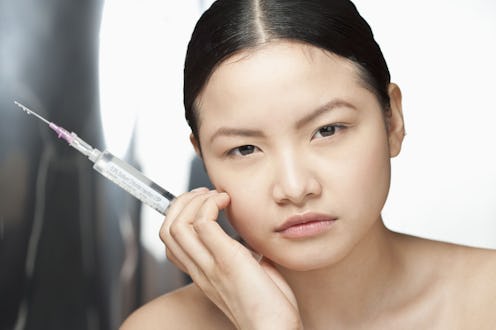(Beauty)
Are Fillers Or Injectables A Better Investment? Here's What A Plastic Surgeon & A Dermatologist Say

By now you've probably realized that your complexion, especially makeup-free in direct sunlight, looks... different than it once did. Despite best practices — a balanced skincare regimen, religious sunscreen application, and gallons of water — it's scientifically impossible to halt all signs of aging, if you'd even want to. After all, the better part of style is making thoughtful choices for the clothes and skin and phase of life you're presently in. But if, for you, that involves calling in the big guns, are fillers or injectables a better investment? I tapped facial plastic surgeon Elizabeth Floyd, M.D. and dermatologist Michael Kassardjian, M.D., based in NY and LA, to understand the pros and cons of each.
First and foremost, both specialist stressed the individuality of each patient, explaining that not only do certain lines bother some people while they don't others, everyone ages differently. One person's frown lines may appear as early as their mid twenties, while others will have only a whisper of crows feet as they turn forty. "Generally speaking though, most people start noticing the signs of aging in their thirties," says Kassardjian, and as we all know, it proceeds from there. That means you're likely beginning a regimen you'll continue — or want to continue — forever, so it's important to consider the long term effects, costs, and upkeep before deciding on a treatment.
The earlier you start with Botox, namely before deep lines set in, the more effective it is.
Assess Where You Are
Where you are in the aging process will determine which course of action you should take. In broad strokes, your twenties are for prevention, your thirties are for intervention, and your forties and beyond typically invite correction. Kassardjian advises younger patients who aren't showing many signs of aging to focus on preventative measures like the use of retinols, antioxidant-infused products, and in-office peels to maintain skin's natural strength and boost collagen production. While these topical treatments are still effective on more mature skin, he recommends patients who are starting to display dynamic lines, graduate to Botox, which on average starts in patients' thirties.
"The earlier you start with Botox, namely before deep lines set in, the more effective it is," explains Floyd. Botox works by deactivating the muscles underlying the area that displays dynamic lines. "Dynamic lines are caused by facial movements, like frowning," Kassardjian explains, "and Botox helps to retrain the face to stop overusing those muscles." The result is a halting and moderate reversal of the lines, but it doesn't do a lot to correct deep or static lines. "Static lines are the lines you see at rest, like naso-labial folds or 'Marionette' lines, and they tend to appear later," Kassardjian says. These lines are more efficiently treated with fillers. Because this trajectory (dynamic lines followed by static lines) is typical, both doctors recommended most people in their thirties start with Botox first. "Not only is it less expensive than filler, but the effects of Botox wear off more quickly, which is ideal if you're trepidatious or aren't happy with the results," says Kassardjian. "Fillers are a bigger commitment, with greater risk of adverse reactions or bruising," he explains.
What if you're considering intervention when you're further down the aging path? Then fillers are likely the smarter investment. "Telltale signs of aging such as flattening of the lip, downturning of the mouth, and sagging cheeks are better treated with filler," Floyd says. "As you age, the bone in your face starts to get reabsorbed by the body," she says, citing the wide eye sockets in an 80-year-old skeleton versus the smaller eye sockets in that of a 2-year-old. "You also experience a loss of fat and soft tissue, all of which make you look tired, particularly around the eyes and the jowls," she explains. "Strategically placed filler in the cheeks or around the occipital bone, particularly in the tear troughs, can work wonders," but there's a caveat. "The saggier the skin, the less impactful the use of filler will be. In those cases, typically in older women, we recommend skipping straight to an eye lift or a face lift," says Floyd.
Add Up Your Options
If you're faced with a range of light lines, let's say in your mid thirties, and you're interested in trying something administered by a needle, Botox is cheaper. While there is a wide range of fillers on the market, with varying degrees of viscosity, they are more costly. "Some offices will allow you to invest in a syringe and use it over the course of multiple visits," says Kassardjian, but if a pay now, use later program isn't available, you'll probably want to opt for Botox first. Of course this all depends on what issue you're addressing, so discuss with your doctor before making any choices. (And yes, you'll want to make sure you are receiving advice and treatment from a licensed professional, as there are scores of imitators who aren't fully versed in facial musculature, and they typically over-treat patients.)
In broad terms, you should take preventative measures with topical treatments in your twenties, adopt Botox as soon as dynamic lines start to form in your thirties, then supplement the Botox with fillers in your forties and beyond. "These actions combine to support the skin and prevent it from aging further," says Kassardjian, so long term, you won't invest as much. In a nut shell, the sooner you start managing your lines, the less you'll spend on them overall.